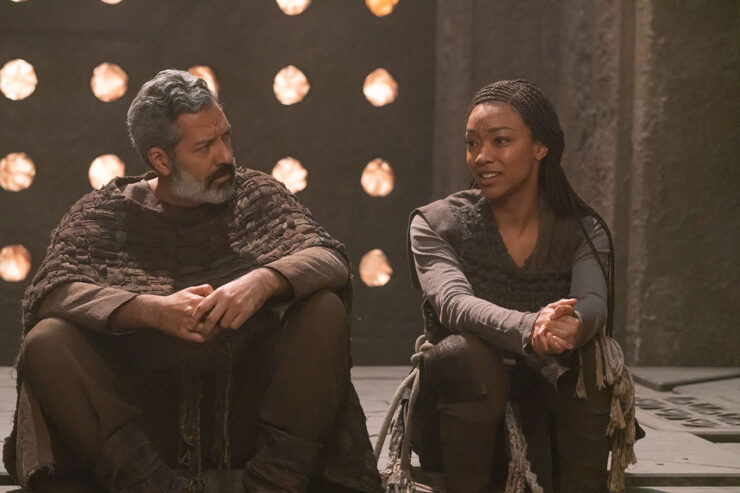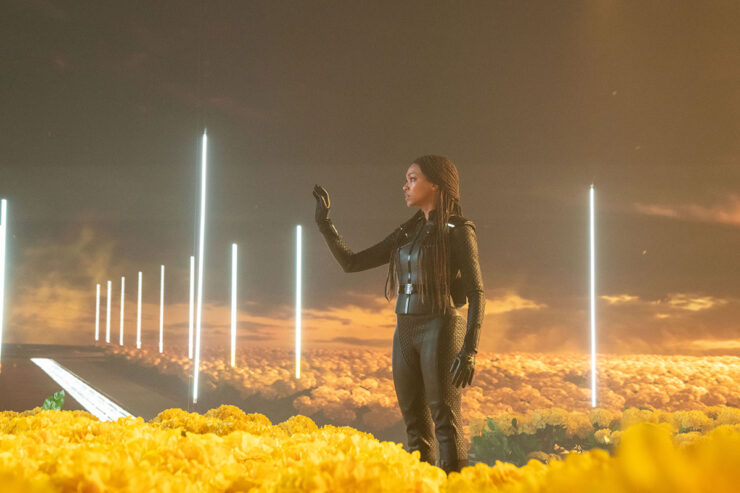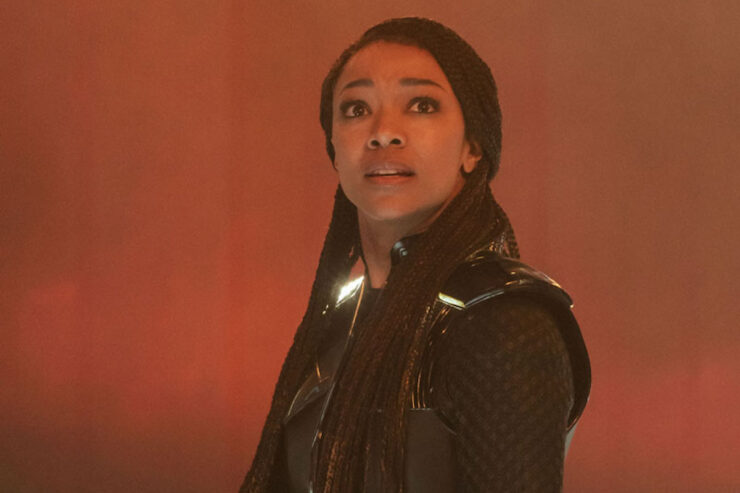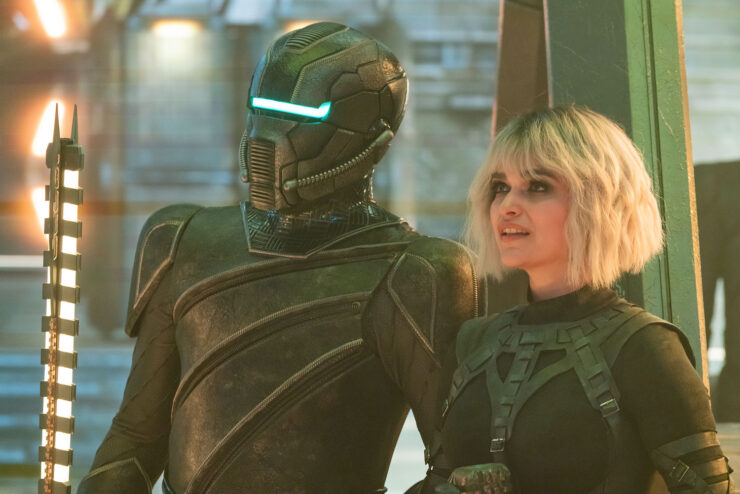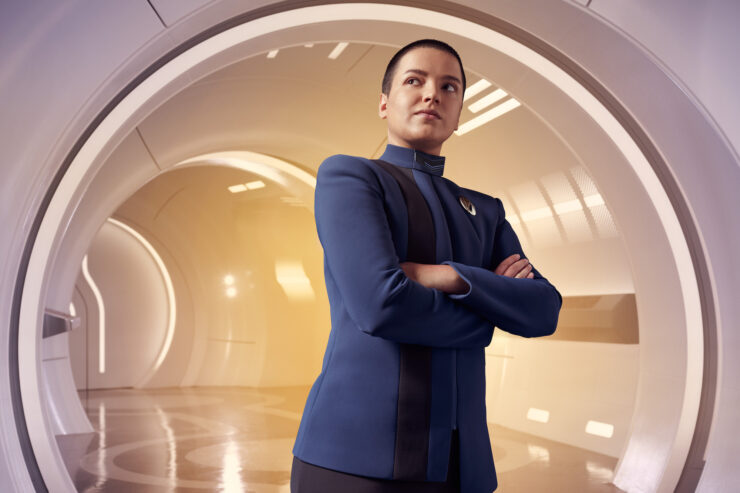The Prime Directive is one of the most complicated tropes to come out of the Star Trek franchise over the past 58 years. Created as it was in the shadow of the Vietnam War (and with the Korean War a recent memory), the notion of a directive that keeps the Federation from sticking their nose where it doesn’t belong (a grave oversimplification) was, I’m sure, very appealing to Gene Roddenberry and his various writers.
Probably the best discussion of the PD was in a TNG episode, “Pen Pals,” specifically a scene in Picard’s quarters. Scripted by the great Melinda M. Snodgrass, the scene beautifully illustrates the complex issues surrounding the non-interference rule. In particular, there’s a line Picard has when he says that the Prime Directive “protects us—to prevent us from allowing our emotions to overwhelm our judgment.”
However, something went horribly wrong with the PD as TNG went on, and it’s infected the remainder of the franchise far too often. In “Pen Pals,” Worf comments that the PD is an absolute, and the entire rest of the scene is a refutation of Worf’s statement. But then the franchise itself doubled down on Worf’s words, leading to—among other things—turning our heroes into idiots in the moronic “Who Watches the Watchers?” and into murderers in the morally repugnant TNG episode “Homeward,” one of the nadirs of the franchise. (See also Enterprise’s “Dear Doctor.”)
“Whistlespeak” is one hundred percent a Prime Directive episode, and it continues the trend—seen also in SNW, particularly “Among the Lotus Eaters”—of moving away from TNG’s dumbshit absolutism.
Because first and foremost, Star Trek is heroic fiction. There’s a reason why so many Trek episodes start with the protagonists responding to a distress call. Trek has always stood out as the franchise that gives us compassion over combat, talking over fighting, and finding ways to help people.
We start this week with the Discovery crew doing what it does best: working its way through a scientific problem. Back in season two, Ethan Peck’s Spock matter-of-factly stated “I like science.” (Peck himself owns a T-shirt with that saying on it that he has worn to many a public appearance.) That’s pretty much the Discovery ethos, and some of the best scenes in this show’s five-year history have been various crewmembers tossing ideas around to figure out a problem. In this case, it’s Stamets, Adria, Tilly, and Burnham trying to determine what the clue they found last week is supposed to mean—which is hard, as it’s just a vial of distilled water with some scratches on it. They’re aided in this by Kovich, who has been able to find a complete list of all five scientists who worked on the Progenitor Project (and who left the clues and erased evidence of their existence). Of the two who are left, they detemine that the latest clue was left by a Denobulan named Hitoroshi Kreel, who did work with weather modification technology, including water reclamation stations that can make it rain. They eventually find a world Kreel designed a water tower for.
The problem is that it’s a pre-warp society. In fact, it’s a pre-technology society, which has built traditions and religion around the water stations, which are high on mountains. It’s assumed that Kreel built them on mountains to avoid PD issues, but he was only partly successful. And the tower itself can’t be beamed into due to some kind of interference. Burnham and Tilly beam down in native garb, and with native markings on their foreheads, to try to get into the tower.
They wind up joining a pilgrimage to the tower, where they meet several locals, including one who is coughing up a proverbial lung due to being stuck in one of the dust storms. At one point, she starts choking to death, but they’re able to cure her by several people getting in a tight circle and each running a stick around a metal bowl, creating a loud resonant sound. The sonics are able to dislodge the dust from the woman’s windpipe.
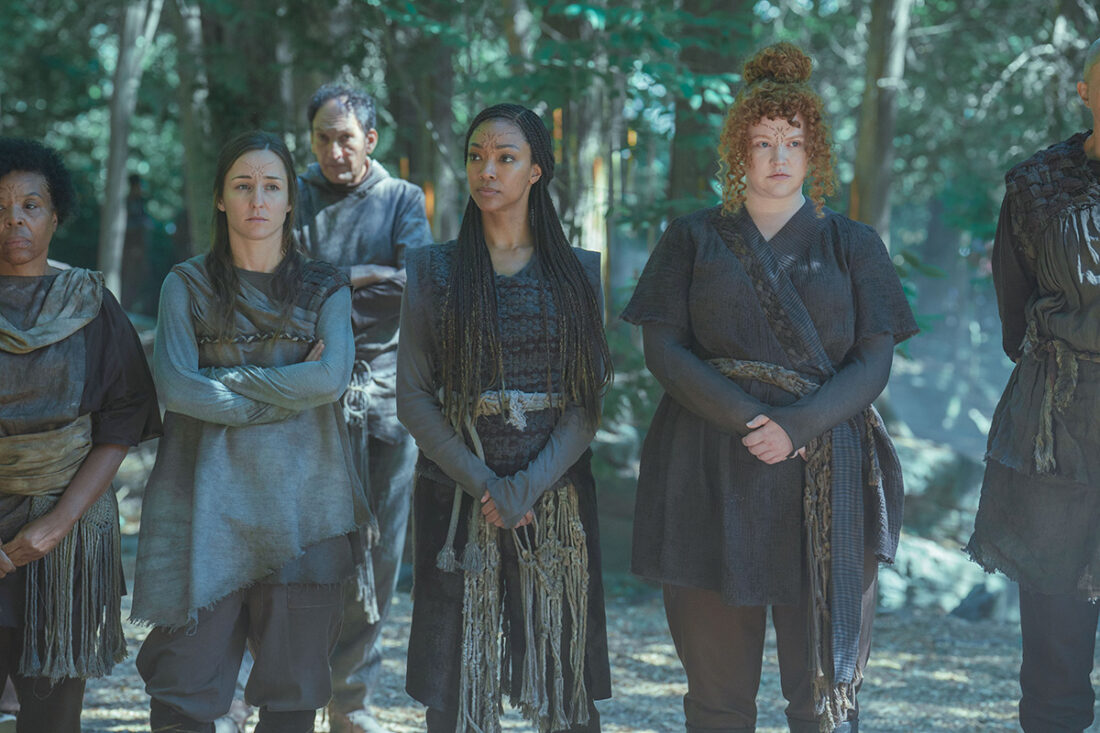
Our heroes soon learn that there’s a ritual involved in getting into the tower involving a race. Because they have to pretend to be natives, Burnham and Tilly don’t ask questions about how the ritual works. Too late, they learn that the race to the tower isn’t just a race: it’s a re-creation of an event from the past, when a woman ran to the tower without water, having sacrificed it to give others water. To that end, they all have to take pills that dry out their throat and they’re not allowed any water until the end of the race. If you drink water—and bowls are left all along the race, thus giving you an easy out, and also proving that they’re not completely insane—then you’re disqualified.
Burnham notices that some moss looks like it’s been contaminated by radiation—something the locals wouldn’t know about—and it may be that there’s a control console she can mess with. She drinks water, disqualifying her, and follows the moss, while Tilly continues to run the race.
In the end, Starfleet training prevails on two different levels. The last two runners are Tilly and Ravah. The latter is that most tired of clichés, the willful child of the single-parent leader who wants to prove themself. Their father doesn’t want them to run the race, and what seems to be over-protectiveness proves to be far worse.
Before we find out how it is, Tilly has to show the other part of Starfleet training, besides the physical fitness: that aforementioned compassion. The last bit of the race is run while holding a bowl of water in hand. Ravah drops their bowl, emptying it, which disqualifies them. But Tilly stops, dumps some of her water into Ravah’s bowl, and they can finish it together.
That’s when the other shoe drops: in order to get rain, the locals make a sacrifice. Whoever wins the race goes into the tower, yes, but the tower also goes through cycles of being sealed.
Aided by Adira, Burnham is able to fix the busted console, and now everything works right. But by this time, Tilly and Ravah are trapped in the tower and going to die, and Discovery can’t beam them out.
So Burnham goes full violate-the-PD and beams into the vestibule even though Ravah’s father is there, lamenting over the fact that he sent his child to their death. Burnham breathlessly explains that it’s a machine, the sacrifices are meaningless, the machine was broken, she fixed it, and get your child and my friend the fuck out of there, please.
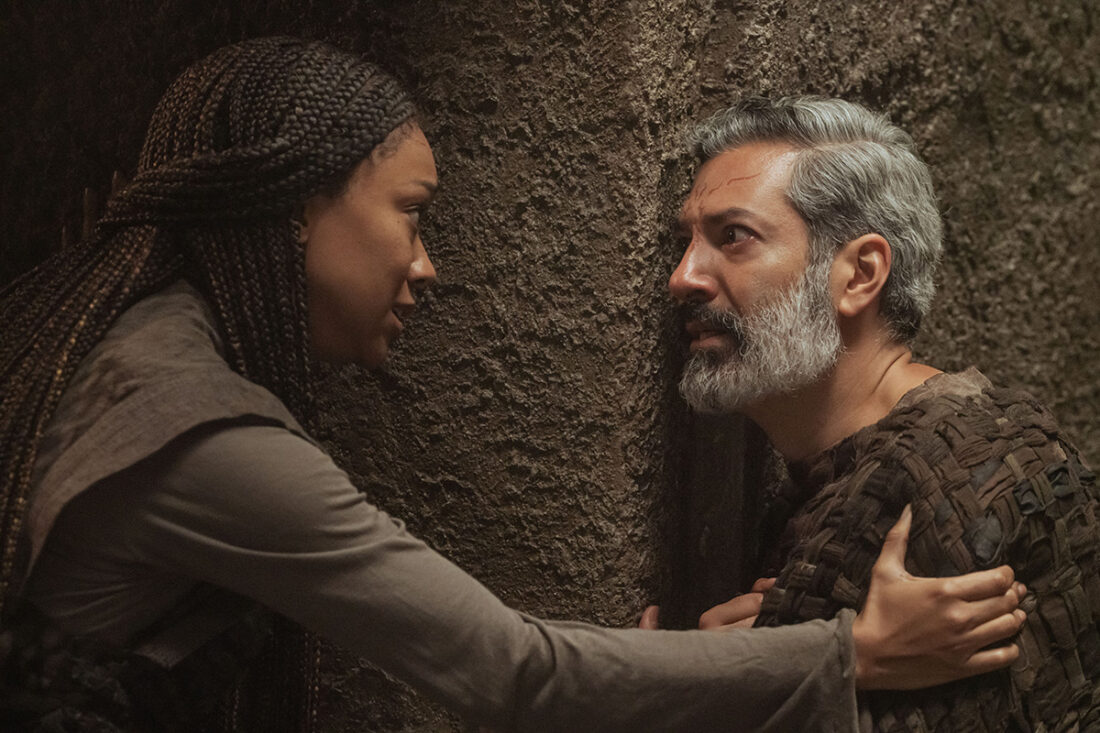
Because yes, the PD is important to protect both the Federation from imperialism and less-technology-developed worlds from being taken advantage of. But it shouldn’t get in the way of stopping people from dying. Worf’s statement and subsequent episodes notwithstanding, the PD is not an absolute and it should never ever ever get in the way of saving lives that can be saved easily. (That “easily” caveat is important.)
And in the end, everybody lives, the locals realize that sacrificing lives to get rain isn’t the best idea, and, oh yeah, it starts raining.
But most importantly: everybody lives.
Two other plotlines at work here, continuing some character work. Rayner assigns Adira to the bridge, as they wanted more time on the bridge, and they’re tasked with helping Burnham fix the tower. The problem is that they’re not sure they’re up to the task, and they try to get Rayner to let someone else handle it. Rayner, however, doesn’t take any of their nonsense, reminding them that the time bug was not their fault, even though they’re carrying major guilt over it.
And we also continue Culber’s trying to come to terms with the zhiantara he went through in “Jinaal.” He talks to a holographic re-creation of his abuela, which is adorable, and she’s the one who convinces him to give himself a medical checkup, make sure there’s no neurological reason for his weird feelings. He also asks Stamets to help—“Nothing as romantic as a neural scan,” Stamets jokes—and they determine that there’s nothing wrong with him physically. Stamets then urges Culber to do something he doesn’t seem to have considered: enjoy it. He feels more connected to everything, and while that is weird, that doesn’t make it bad. We haven’t seen much of Culber and Stamets as a couple lately, and this is a welcome return to it, especially this more mature Stamets who is much better at seeing the big picture than he used to be.
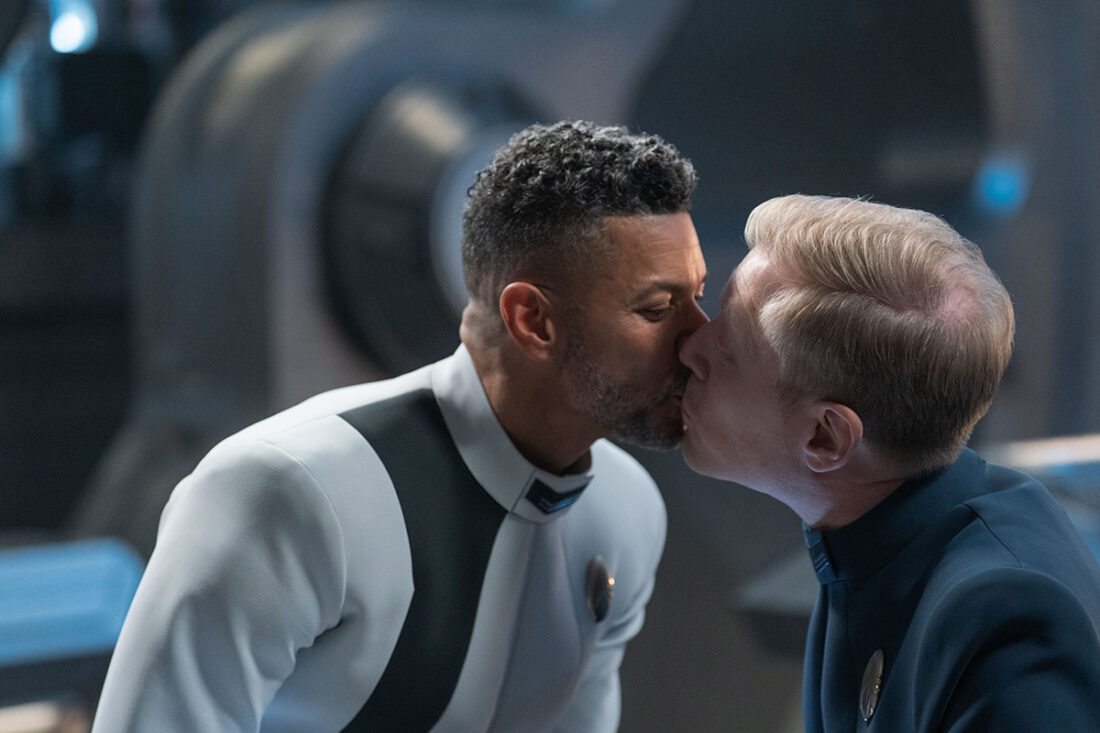
I’m a little disappointed more wasn’t done with the whistling method of communicating over long distances. Ultimately, it’s there to show that the people are genuinely alien, which is certainly appreciated, but given that it’s the title of the episode, I was expecting it to play a bigger role in the plot. Ah, well. And I do like that they have retinal tricorders and subcutaneous communicators for ease of clandestine infiltration…
The scratches on the vial turned out to match a number in the native language, specifically the number five. The next piece of the puzzle was in Tower #5, as well as some writing in the Betazoid language. Since the fifth and final scientist was a Betazoid named Marina Derex, this makes sense. One assumes we’ll find out what that text said next week…










